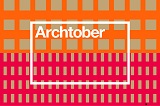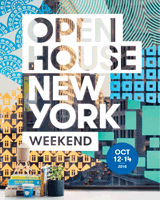
Today’s News - Thursday, October 11, 2018
EDITOR'S NOTE: Tomorrow and Monday will be no-newsletter days - also Tuesday: weather gods willing, we'll be on an early-morning ferry to preview FXCollaborative/ESI's Statue of Liberty Museum on Ellis Island!
It's a Stirling kind of day:
● Wainwright says Foster's Bloomberg HQ in London is "a gargantuan temple to gadgetry, its every detail subjected to months of research and development. But for all their trailblazing innovations, it is hard to escape the feeling of being trapped in a very deep-plan office building. It is a very inward-looking place."
● Woodman wonders: "Why has one of the most expensive office buildings ever built won the Stirling Prize in the middle of a housing crisis?" While "there is much to admire" about this "work of fastidious contextualism," this "exceptionally lavish project hardly represents a model likely to be replicated soon."
● On a brighter note: Foster's "astounding" and "boundary pushing" Bloomberg HQ was "praised by the jury as a 'monumental achievement'" (but it was not the bookmakers' or AJ readers' favorite).
● The profession "reacts to Foster + Partners' opinion-splitting 2018 Stirling Prize victory" - mostly thumbs-up's, but some thumbs-down (Comments sections in all worth a gander, too).
In other news:
● Russell (he's back!) delves into the effect of gentrification on urban communities, and how "designers and policymakers are looking for ways to attract needed investment without displacing longtime lower-income residents" [link to "The Housing Crisis in America" series by John King, Cathleen McGuigan, Suzanne Stephens, etc.).
● Eyefuls of Kuma's Starbucks Taiwan made from shipping containers - "yet another striking and innovatively-designed coffee house" where natural light transforms "the density and darkness of a shipping container into a pleasant habitable space."
● Eyefuls of Carme Pinós's "origami-inspired" MPavilion in Melbourne's Queen Victoria Gardens - its 4-month program "includes a focus on women in leadership."
Weekend diversions:
● A look at the "stellar" lineup of films and programs offered in the 10th annual Architecture and Design Film Festival, which kicks off next Tuesday in NYC (with links to trailers and a discount ticket offer).
● Trailers for the 2018 AIA Film Challenge winners, also being screened at ADFF (not named or linked is the International winner: Kathryn Sanders' "Freedom to Play").
● Budds parses "Close to the Edge: The Birth of Hip-Hop Architecture" at NYC's Center for Architecture, which "makes an urgent case for why" hip-hop can "make architecture more equitable," or could it "simply become another buzz-phrase co-opted by commercial interests, ultimately rendering it superficial" (hopefully, not).
● Lutyens cheers "Anni Albers" at the Tate Modern - it's about time she and the "many brilliant" but "forgotten women of the Bauhaus" get their due.
● McCarty cheers "Beazley Designs of the Year 2018" at London's Design Museum that "highlights the best new innovations, many from Asia" - but "there's much more than just mushrooms, magic or otherwise" (with kudos to Aric Chen).
● McMullan says "Living with Buildings" at London's Wellcome Collection "charts the influence manmade structures have had on health and wellbeing - as 'wellness' becomes a fashionable word once more, value is again being placed on the power buildings have over physical and mental health."
● ArcSpace's Wells delves deep into innovation, and how "Possible Spaces" in the Danish Pavilion at the Biennale "demonstrates the role of design in achieving collaborative and sustainable innovation."
● Meanwhile, in Copenhagen, the Danish Architecture Center presents "Ove Arup and the Philosophy of Total Design," which looks at how the Dane "revolutionized architecture and the way that engineering is practiced today."
Page-turners:
● An excerpt from Speck's "Walkable City Rules: 101 Steps to Making Better Places": "Rule 88: Make sticky edges; Rule 100: Don't give up on sprawl. It's where most Americans live."
● Moore's take on Klinenberg's "Palaces for the People: How to Build a More Equal and United Society": The "sociologist is eloquent on the importance of creating shared urban spaces - but vague on how to make it happen" (Speck's book might come in handy!).
● Anderton has a lively conversation with Klinenberg, whose impetus for "Palaces for the People" was the post-Hurricane Sandy 'Rebuild by Design' competition - he "makes the case that communities with strong 'social infrastructure' can survive stressful events."
● Beske and Dixon's "Suburban Remix: Creating the Next Generation of Urban Places" makes "a compelling case for transforming the country's aging suburban population centers into dense, walkable communities, but ultimately fails to demonstrate how broadly applicable that model may be," but it is "a valuable resource" for for anyone "engaged in large-scale re-imagining of what a suburb can be."
● ICYMI: ANN feature: Taylor's Venice in Three Parts: As a first-timer to La Biennale di Venezia; There are immersive experiences, artistic expressions, and marketing efforts. Guess which are most satisfying; There are treasures and treats to be found beyond the confines of the Giardini.
| |





|
|
|
To subscribe to the free daily newsletter
click here
|
Oliver Wainwright: Norman Foster's Bloomberg office in London wins Stirling prize: One of the most environmentally friendly office buildings ever conceived...a gargantuan temple to gadgetry, its every detail subjected to months of research and development...an elaborate monument to Bloomberg's belief that “businesses have a role to play in saving the planet”...But for all their trailblazing innovations, it is hard to escape the feeling of being trapped in a very deep-plan office building...It is a very inward-looking place... -- Foster + Partners [images]- Guardian (UK) |
Ellis Woodman: Why has one of the most expensive office buildings ever built won the Stirling Prize in the middle of a housing crisis? There is much to admire, and yet the decision to award such an exceptionally lavish project...is certain to be questioned. Given that its budget comfortably exceeds that of every other project on the shortlist combined, [it] hardly represents a model likely to be replicated soon...a work of fastidious contextualism...It is one of the cherries on a large and less than palatable cake. If future juries really wants to contribute to the evolution of British architecture they would do well dig a little deeper. -- Foster + Partners [images]- Telegraph (UK) |
Foster + Partners’ £1bn Bloomberg HQ wins 2018 RIBA Stirling Prize: ...’astounding’ and ‘boundary pushing’ new European headquarters for media giant...Billed as the world’s most sustainable office and praised by the jury as a ‘monumental achievement’...[it] was not the bookmakers’ favourite...Nor was it the pick of the AJ readers...judges were wowed by Bloomberg’s ’restrained exterior and dynamic interior’, the ’unprecedented levels of research, innovation and experimentation’...- The Architects' Journal (UK) |
RIBA Stirling Prize reaction: ‘The money wins it’: The profession reacts to Foster + Partners’ opinion-splitting 2018 Stirling Prize victory.- The Architects' Journal (UK) |
James S. Russell: Gentrification's Effect on Urban Communities: For decades, cities sought investment to revive blighted streets and bring economic activity back to decimated neighborhoods...Where cities have prospered and real-estate values soared, designers and policymakers are looking for ways to attract needed investment without displacing longtime lower-income residents...How did gentrification turn into a losing proposition for low-income neighborhoods? ...there is a growing consensus about how cities can manage development pressure for everyone’s benefit. -- Interface Studio Architects; Stevens and Wilkinson Architects; SHoP Architects; Susan Rodriguez/Ennead [link to "The Housing Crisis in America" series]- Architectural Record |
Kengo Kuma Creates Starbucks Store in Taiwan From 29 Shipping Containers: Hot on the heels of its lavish breakthrough Milan store...yet another striking and innovatively-designed coffee house...an entirely different mood...the company has opened over 40 coffee locations in structures that utilize a shipping container as a fundamental building block...design utilizes a series of skylights and single pane windows to allow natural light...transforming the density and darkness of a shipping container into a pleasant habitable space... [images]- ArchDaily |
Carme Pinós unveils origami-inspired MPavilion raised up on grass mounds: ...in Melbourne's Queen Victoria Gardens...annual commission, known as Australia's answer to the Serpentine Pavilion...This year's programme includes a focus on women in leadership...At the end of its four-month tenure, the building will be gifted to the city and moved to a permanent new home. thru February 3, 2019 -- Naomi Milgrom Foundation [images]- Dezeen |
Architecture and Design Film Festival to kick off 10th year with heavy-hitting lineup: 10th annual ADFF kicks off in New York City October 16-21 and the lineup is stellar...will present over 30 feature-length and short films as well as interactive experiences, pop-up installations, and panel discussions...Curbed readers can purchase discounted tickets...Check out some of our favorite trailers... [videos]- Curbed |
2018 AIA Film Challenge winners: ...part of the institute's larger Blueprint for Better campaign...This year’s film submissions covered a variety of topics, including affordable housing, social impact issues, preservation and sustainability. Grand Prize, Runner-Up, Third Place, and People’s Choice Award -- Cheryl Hess/Kramer + Marks Architects; Chris Langer/Robert P. Madison International; Isaiah Rendon/Overland Partners [videos]- ArchDaily |
Diana Budds: Can hip-hop make architecture more equitable? “Close to the Edge: The Birth of Hip-Hop Architecture" at the Center for Architecture [NYC], makes an urgent case for why it can: But in hailing a countercultural philosophy as the next great mainstream movement in architecture, will the exhibition also hammer a nail in its coffin? ...using architecture as a tool to achieve spatial justice and social equity is a foundational goal...However, there is concern that this ethic might get lost if hip-hop architecture is appropriated...[it] could simply become another buzzphrase co-opted by commercial interests, ultimately rendering it superficial...But appropriation, in a negative light, isn’t necessarily Hip-Hop Architecture’s fate. thru January 12, 2019 -- Sekou Cooke; Craig Wilkins; Michael Ford [images]- Curbed |
Dominic Lutyens: Anni Albers and the forgotten women of the Bauhaus: Many brilliant female designers were part of the famously forward-thinking German movement. But how progressive was it really? Influenced by modernism and its rejection of artistic tradition and commitment to a socially democratic future facilitated by good, functional design...[it] was far from socially progressive...While the Bauhaus men are considered design titans today, their female counterparts are relatively unknown. "Anni Albers" at Tate Modern, London, thruJanuary 27, 2019 -- Walter Gropius; Libby Sellers/"Women Design"; Mies van der Rohe; László Moholy-Nagy; Marcel Breuer; Gunta Stölzl; Marianne Brandt [images]- BBC Designed |
Stephen McCarty: Asian innovation to the fore in show of year’s best designs: An astronaut’s boot grown from fungus and human sweat, urban micro parks, earthquake-resistant homes - the Design Museum of London highlights the best new innovations, many from Asia: “Beazley Designs of the Year 2018”...there’s much more to the 11th iteration of the Beazley awards than just mushrooms, magic or otherwise..."we’ve also tried to show how designers are responding to uncertainty, acknowledging that we live in an increasingly uncertain world." thru January 6, 2019 -- Aric Chen/M+ [images]- South China Morning Post |
Thomas McMullan: Designing Wellness: What Influence Does Architecture Have on Health? "Living with Buildings" at London’s Wellcome Collection charts the influence manmade structures have had on health and wellbeing: ...as ‘wellness’ becomes a fashionable word once more, value is again being placed on the power buildings have over physical and mental health. thru March 3, 2019 -- Alvar Aalto; Robert Francis Wilson; Ivan Harbour/Rogers Stirk/Rogers Stirk Harbour + Partners [images]- Frieze |
Benjamin Wells: Innovation by Design: Innovation has always been inevitable, and is becoming increasingly so. But it has now become an imperative, precisely because of the severity of the problems it has left in its wake...The Danish Pavilion at the 2018 Venice Architecture Biennale presents four projects that demonstrate the role of design in achieving collaborative and sustainable innovation..."Possible Spaces" places emphasis on this process rather than its final output. [images]- ArcSpace |
"Ove Arup and the Philosophy of Total Design" at the Danish Architecture Center, Copenhagen: Many of us know the iconic Sydney Opera House and Centre Pompidou in Paris. But a few of us know one of the key figures behind. The Dane, Ove Arup, revolutionized architecture and the way that engineering is practiced today. He called his philosophy “Total Design” because he believed that great architecture is accomplished when technique, design and aesthetics unite. [images]- ArcSpace |
Jeff Speck: A Step-by-Step Guide for Fixing Badly Planned American Cities: An excerpt from Speck’s "Walkable City Rules: 101 Steps to Making Better Places": Rule 9: Fix your codes; Rule 88: Make sticky edges; Rule 100: Don’t give up on sprawl. It’s where most Americans live.- CityLab (formerly The Atlantic Cities) |
Rowan Moore: "Palaces for the People: How to Build a More Equal and United Society" by Eric Klinenberg: A US sociologist is eloquent on the importance of creating shared urban spaces - but vague on how to make it happen: It champions “social infrastructure”...Its theme is important and timely, but it leaves you wanting more...if you made the background of the book its foreground, it would be a devastating portrayal of fragmentation, despair and disruption. But Klinenberg, an optimist, tells heartwarming stories...What [it] lacks is a desire to tackle the hard questions, such as: how much do things like this cost and how are they paid for?- Observer (UK) |
DnA: Frances Anderton: Can social infrastructure repair a broken society? “Palaces for the People: How Social Infrastructure Can Help Fight Inequality, Polarization, and the Decline of Civic Life" by Eric Klinenberg: The impetus for his book was his involvement in the ‘Rebuild by Design’ competition...launched after Hurricane Sandy...he learned how resilient infrastructure...can also serve as multipurpose, gathering places - a berm that becomes a park, for example...book makes the case that communities with strong “social infrastructure” can survive stressful events.- KCRW (Los Angeles) |
Hope and Doubt about the Future of Walkable Suburbia: "Suburban Remix: Creating the Next Generation of Urban Places"...edited by Jason Beske and David Dixon...makes a compelling case for transforming the country’s aging suburban population centers into dense, walkable communities, but ultimately fails to demonstrate how broadly applicable that model may be...the authors...are optimistic about suburbia’s future...The bulk of the book, however, consists of case studies...The American southeast and southwest - regions where the lessons from this book are arguably most urgently needed - are notably absent...Despite these shortcomings, [it] represents a valuable resource for policymakers, planners, and designers engaged in large-scale re-imagining of what a suburb can be.- The Dirt/American Society of Landscape Architects (ASLA) |
ANN feature: Julie D. Taylor: Venice in Three Parts - Part 3: There are treasures and treats to be found beyond the confines of the Giardini della Biennale. [images + links to Parts 1 and 2]- ArchNewsNow.com |
|
|
Note: Pages will open in a new browser window.
External news links are not endorsed by ArchNewsNow.com.
Free registration may be required on some sites.
Some pages may expire after a few days.
© 2018 ArchNewsNow.com


